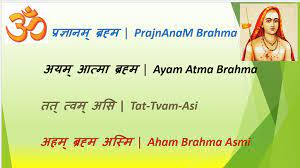The Mahavakya Upanishad (The Great Utterances of Oneness)
The Mahavakya Upanishad (The Great Utterances of Oneness)
The text describes the nature of Atman (self, soul) and Brahman (ultimate reality), then asserts that they are identical and liberation is the state of fully understanding this identity. It asserts that Yoga and introspection is the way to spiritual knowledge, with the help of a guru. The concept of Mahavakyas emerged as a means to express the fundamental unity of the individual soul (Atman)and the universal consciousness (Brahman) and highlights its significance in guiding seekers towards self-realization and liberation.
The Upanishad expounds on the philosophy of Advaita Vedanta, emphasizing the essential unity of the individual self (Atman) and the universal consciousness (Brahman). It teaches that the apparent duality experienced in the world is an illusion, and realizing the truth of oneness leads to liberation and spiritual enlightenment. It highlights the importance of self-inquiry and self-realization in recognizing one’s true identity. By contemplating upon the Mahavakyas, individuals can transcend the limited sense of self and recognize their essential nature as divine and interconnected with all of creation.
The Upanishad provides insights into transcending the illusion of duality and realizing the underlying unity of existence. It teaches that by understanding the Mahavakyas and directly experiencing the truth they convey, individuals can go beyond the limitations of the mind and ego, embracing the all-pervading consciousness. It emphasizes the practical application of the Mahavakyas in daily life. It teaches that the realization of oneness should translate into compassion, love, and respect for all beings, fostering harmony and unity in the world.
Its teachings hold immense relevance in contemporary times, offering profound guidance to individuals seeking spiritual growth, self-realization, and the transcendence of duality. The Mahavakyas serve as power full reminders of the inherent unity underlying all diversity, inspiring individuals to cultivate a sense of interconnectedness and foster a harmonious existence. By delving into the teachings of this Upanishad, individuals can gain deeper insights into the nature of reality, self-realization, and the path to transcending duality. The Upanishad serves as a guiding light, empowering seekers to realize the inherent unity and divinity within themselves and in all of creation.


Comments
Post a Comment